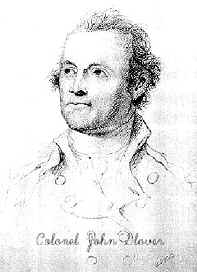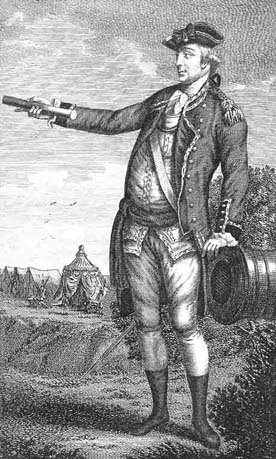
|
It was Wednesday, September 5, 1775 and an armed schooner of uncertain origin sailed forth upon North Shore waters under the orders of none other than General George Washington himself. The sailors and officers of the now famous Hannah were ordered to seize "such Vessels as may be found on the High seas or elsewhere, bound inward and outward to or from Boston in the Service of the ministerial Army."
The only eyewitness account we have of this momentous event is a short journal entry made that day by Ashley Bowen, a Marblehead sailmaker and chronicler of occurrences in his beloved community. The entry reads: "Sailed on an Unknown Experdishon a Schooner of Capt John Glovers Nick Broden (Broughton) Capt of Mereens (marines) and John Gail (Gale) Mastor of Schooner." Upon being immediately sighted by HMS Lively, the Hannah sailed directly for the safety of Gloucester Harbor. This is certainly not what we have come to expect from legends of history, but this little story marked the beginning of the American Navy and the long history of the world's most powerful marine forces ever known. From small beginnings great history is often written and the saga of Marblehead and her little ship, the Hannah, are proof of that. And, it should be noted, that nuance and inference often confuse simple beginnings causing controversy where there really should be none. In the dust of history many facts are conveniently overlooked.  In the controversy concerning where exactly the American Navy began there are many contenders: Philadelphia, Pennsylvania; Whitehall, New York; Beverly, Massachusetts; and Portsmouth, New Hampshire have all made claims to be the "birthplace." But, in the case of the Hannah, no other claim has the two important components of Marblehead's: the direct orders of George In the controversy concerning where exactly the American Navy began there are many contenders: Philadelphia, Pennsylvania; Whitehall, New York; Beverly, Massachusetts; and Portsmouth, New Hampshire have all made claims to be the "birthplace." But, in the case of the Hannah, no other claim has the two important components of Marblehead's: the direct orders of George Washington (right) to attack the British, and an owner/captain and crew so clearly from one small New England seacoast community. Beverly's claim is based on the fact that Hannah often berthed and resupplied in Beverly's safe shallow-water harbor. While without Beverly's facilities Hannah would have had a much harder time, and therefore her role in establishing a Navy is rock solid, the birthplace of the American Navy can be no other than the town where the ship called home port, where the owner/captain lived and where the vast majority, if not all, of the original crew lived as well. Out of Marblehead's maritime ways and history came the ship, crew and know-how to carry out General Washington's command. How and where they did is also part of history, but a later part than the beginning, the birth if you will. Washington (right) to attack the British, and an owner/captain and crew so clearly from one small New England seacoast community. Beverly's claim is based on the fact that Hannah often berthed and resupplied in Beverly's safe shallow-water harbor. While without Beverly's facilities Hannah would have had a much harder time, and therefore her role in establishing a Navy is rock solid, the birthplace of the American Navy can be no other than the town where the ship called home port, where the owner/captain lived and where the vast majority, if not all, of the original crew lived as well. Out of Marblehead's maritime ways and history came the ship, crew and know-how to carry out General Washington's command. How and where they did is also part of history, but a later part than the beginning, the birth if you will.John Glover owned the little ship. He was, at the time, a long-time prominent Marblehead merchant and a colonel in Washington's army, garrisoned in Cambridge. Nicholson Broughton was a n experienced sea captain and Marbleheader. In an exhaustive and authoritative study entitled: "In Troubled Waters: The Elusive Schooner Hannah," The Peabody Museum, 1970 by C. F. Smith and Russell W. Knight, took all of speculation about the origins of the Hannah, where was she constructed?, when?, who was her captain?, who were the men of her crew?, was there just one Hannah or many?, and put the real story on firm historic ground once and for all. Because records of ships' clearances from the colonies are non-existent due to the evacuation of the British from Boston and various fires affecting custom houses (including one in Salem) the authors reled on records of ships' clearances from Barabados and concluded that there were several Hannahs owned by the Glover family. One was owned by Jonathon, John Glover's brother (as confusing as that is) and was named for his daughter, Hannah. There was a second one, owned by John Glover, and named for his wife, the former Hannah Gale. The former, captained at one time by Richard James, John Glover's borther-in-law, and later by Richard Stiles, who was lost at sea in the West Indies. The authors also discovered that John Glover's Hannah, listed in Glover's "Colony Ledger" as 78 tons, was actually smaller than that; actually 45 to 50 tons. Based on Smith and Knight, the Hannah was a vessel with a keel of 43 feet, a beam of 16.5 feet, and a seven-foot depth of hold.  Pictured above: the Hannah running the Gauntlet avoid a British patrol. There are no documents to substantiate Beverly's claim to the "Birthplace." There is a tradition of them saying it, and it is clear from oral history that John Glover's expanding business did make use of his facilities in Beverly. While provisioning the Hannah, Glover did scoured the entire Massachusetts Bay area in search of guns, sails, and supplies. He probably did berth the vessel in Marblehead and Beverly. But Barbados records lists the Hannah, of Marblehead, as late as July 5, 1775. A second notation in Bowen's Journal dated June 6, 1775: "This afternoon Arived John Gail (John Glover's captain) from Burbados and he Run the Gantlet and Pased ye Marling (HMS Merlin) and Run in to the Worfe (wharf). C John Glover went of (off) and met her and the Marlons Barge mett her at the Same Time the Offeser of the Barge order her to Bring two (to) Glover ordered her not and the Schooner Run under the Ship Starne. All is Well that Ends Well," he concluded. All of this took place in Marblehead Harbor, emphasizing the fact that Marblehead was home port to the Hannah and undermining Beverly's faulty historical claim of inference. |